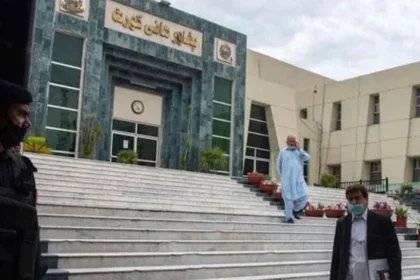Introduction: Lahore’s Alarming Air Quality
Lahore, Pakistan’s cultural capital, known for its historical architecture and vibrant atmosphere, has now gained international attention for a less favorable reason. According to recent global rankings, Lahore is the second most polluted city in the world. This alarming status has sparked significant concern among residents, environmentalists, and policymakers alike. The city’s deteriorating air quality poses severe health risks, environmental challenges, and long-term socioeconomic impacts.
This article delves into the factors contributing to Lahore’s pollution, the implications of such high pollution levels, and the measures that can be taken to mitigate the crisis.
Causes of Air Pollution in Lahore
Several factors contribute to Lahore’s dangerously high pollution levels, with air quality often reaching “hazardous” levels, particularly during the winter season.
1. Vehicle Emissions
One of the primary contributors to air pollution in Lahore is vehicular emissions. The city’s rapid urbanization has led to a significant increase in the number of vehicles on the road, many of which run on substandard fuel and lack proper emission control systems. The high concentration of nitrogen oxides, carbon monoxide, and particulate matter from vehicles has drastically worsened the air quality.
2. Industrial Pollution
Lahore is home to various industries, many of which emit pollutants without adequate regulation. Factories and manufacturing plants, especially in the outskirts, contribute to the release of harmful gases such as sulfur dioxide and carbon dioxide into the atmosphere. Industrial emissions often go unchecked, adding to the environmental burden on the city.
3. Burning of Crop Residue
The practice of burning crop residue in Punjab and neighboring Indian states, particularly in the winter months, significantly worsens Lahore’s air quality. This phenomenon creates dense smog, which blankets the city, reducing visibility and contributing to respiratory issues for the population. Crop burning emits large amounts of particulate matter and other pollutants into the air, worsening the overall pollution levels.
4. Construction Activities
With Lahore’s continuous expansion, construction projects are always underway. Dust from construction sites, along with emissions from heavy machinery, contribute to the rise in particulate matter in the air. Inadequate dust control measures exacerbate the situation, leading to further degradation of the city’s air quality.
5. Energy Production
Pakistan’s reliance on fossil fuels for energy generation, including coal and natural gas, also plays a significant role in Lahore’s pollution levels. Power plants located near the city release large quantities of carbon dioxide and other harmful pollutants, which directly affect air quality.
Impacts of Pollution on Health
The alarming pollution levels in Lahore have severe health implications for its residents. Prolonged exposure to pollutants such as particulate matter (PM2.5 and PM10), sulfur dioxide, and nitrogen dioxide can lead to a range of health problems.
1. Respiratory Diseases
Lahore’s air pollution has caused a rise in respiratory diseases such as asthma, chronic bronchitis, and lung infections. The dense smog during the winter months, in particular, worsens these conditions, with hospitals reporting an influx of patients suffering from breathing difficulties.
2. Cardiovascular Issues
Pollution also has a significant impact on cardiovascular health. Studies have shown a direct link between air pollution and an increased risk of heart attacks, strokes, and other heart-related illnesses. The high levels of particulate matter in Lahore’s air contribute to the inflammation of blood vessels, increasing the risk of heart diseases.
3. Impact on Children and the Elderly
Children and the elderly are especially vulnerable to air pollution. For children, long-term exposure can result in stunted lung development, while the elderly, particularly those with pre-existing health conditions, are at a higher risk of complications such as pneumonia and heart failure.
Environmental Consequences
The environmental implications of Lahore’s pollution crisis are just as concerning. Pollutants in the air not only affect human health but also have far-reaching effects on the environment.
1. Damage to Vegetation
High levels of air pollution have been shown to damage plant life. In Lahore, the smog that blankets the city during winter hinders photosynthesis in plants, weakening their growth and vitality. This, in turn, affects local ecosystems and biodiversity.
2. Climate Change Contribution
The emissions from vehicles, industries, and power plants in Lahore contribute significantly to global greenhouse gas levels, accelerating climate change. The increase in carbon dioxide and methane emissions leads to higher global temperatures and exacerbates the impact of climate change on the region.
3. Water and Soil Pollution
Airborne pollutants eventually settle on the ground and in water bodies, contaminating soil and water sources. This not only affects agriculture but also poses a threat to food security, as polluted soil can lead to lower crop yields and contaminated food.
Government Response and Challenges
The Pakistani government has recognized the severity of Lahore’s pollution crisis and has taken several steps to combat it. However, these measures often face implementation challenges.
1. Smog Control Initiatives
The Punjab government has introduced several initiatives aimed at reducing smog, including the imposition of fines on industries that violate environmental regulations and restrictions on the burning of crop residue. The government has also implemented a smog emergency plan during the winter months, advising citizens to take precautions and limit outdoor activities during peak smog days.
2. Vehicle Emission Standards
To address vehicular pollution, the government has introduced vehicle inspection and emission testing systems. However, enforcement remains weak, with many vehicles on the road still failing to meet emission standards.
3. Alternative Energy Sources
The government has also explored the promotion of renewable energy sources, such as solar and wind power, to reduce the reliance on fossil fuels. However, the transition to cleaner energy sources is slow and faces significant financial and infrastructural challenges.
Potential Solutions to Lahore’s Pollution Crisis
Addressing Lahore’s pollution problem requires a multifaceted approach that involves the government, industries, and citizens. Here are some potential solutions to the crisis:
1. Stricter Regulation and Enforcement
The government must implement stricter regulations on industries and vehicles, with heavy penalties for those that violate environmental standards. Effective enforcement is key to ensuring compliance with emission limits and reducing pollution levels.
2. Public Transport and Green Initiatives
Encouraging the use of public transportation, cycling, and walking can help reduce vehicular emissions. Additionally, the promotion of electric vehicles and the expansion of green spaces in the city can contribute to cleaner air.
3. Public Awareness Campaigns
Raising public awareness about the health risks associated with pollution and the steps individuals can take to minimize their exposure is crucial. The government should launch campaigns encouraging citizens to adopt eco-friendly practices, such as reducing energy consumption and limiting vehicle use.
4. Investment in Renewable Energy
A long-term solution to Lahore’s pollution problem lies in investing in renewable energy sources. Transitioning from fossil fuels to cleaner energy options can significantly reduce emissions and improve air quality in the city.
A Path Forward for Lahore
Lahore’s status as the second most polluted city in the world is a wake-up call for Pakistan. While the challenges are significant, the path to cleaner air and a healthier environment is possible through concerted efforts by the government, industries, and citizens. By implementing stricter regulations, promoting green initiatives, and investing in renewable energy, Lahore can begin to tackle its pollution crisis and improve the quality of life for its residents.
#LahoreAirPollution #EnvironmentalCrisis #SmogInLahore #CleanAir #PollutionControl #AirQuality #SustainableLiving #RenewableEnergy #GreenInitiatives #PublicHealthRisks







